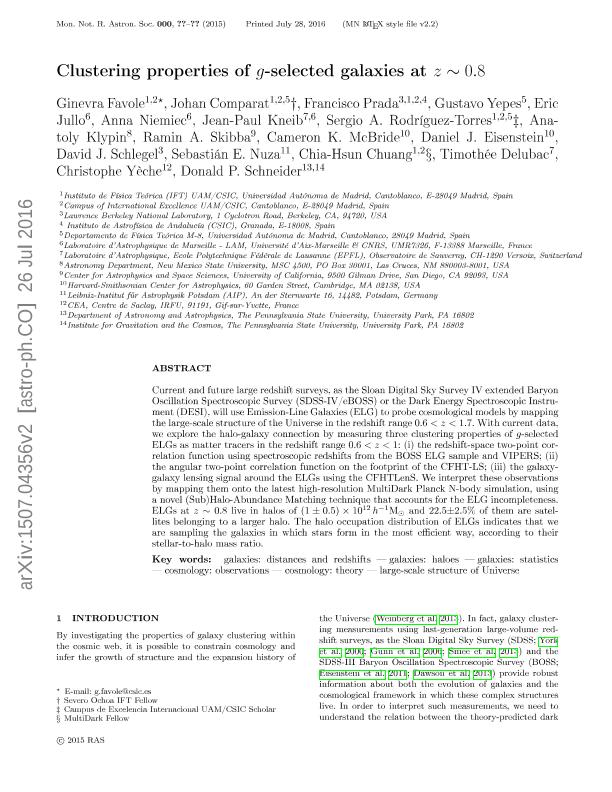Artículo
Clustering properties of g-selected galaxies at z ~ 0.8
Favole, Ginevra; Comparat, Johan; Prada, Francisco; Yepes, Gustavo; Jullo, Eric; Niemiec, Anna; Kneib, Jean-Paul; Rodriguez Torres, Sergio A.; Klypin, Anatoly; Skibba, Ramin A.; McBride, Cameron K.; Eisenstein, Daniel J.; Schlegel, David J.; Nuza, Sebastian Ernesto ; Chuang, Chia-Hsun; Delubac, Timotheé; Yèche, Christophe; Schneider, Donald P.; Schneider, Donald P.
; Chuang, Chia-Hsun; Delubac, Timotheé; Yèche, Christophe; Schneider, Donald P.; Schneider, Donald P.
 ; Chuang, Chia-Hsun; Delubac, Timotheé; Yèche, Christophe; Schneider, Donald P.; Schneider, Donald P.
; Chuang, Chia-Hsun; Delubac, Timotheé; Yèche, Christophe; Schneider, Donald P.; Schneider, Donald P.
Fecha de publicación:
10/2016
Editorial:
Wiley Blackwell Publishing, Inc
Revista:
Monthly Notices of the Royal Astronomical Society
ISSN:
0035-8711
Idioma:
Inglés
Tipo de recurso:
Artículo publicado
Clasificación temática:
Resumen
Current and future large redshift surveys, as the Sloan Digital Sky Survey IV extended Baryon Oscillation Spectroscopic Survey (SDSS-IV/eBOSS) or the Dark Energy Spectroscopic Instrument (DESI), will use emission-line galaxies (ELGs) to probe cosmological models by mapping the large-scale structure of the Universe in the redshift range 0.6 < z < 1.7. With current data, we explore the halo-galaxy connection by measuring three clustering properties of g-selected ELGs as matter tracers in the redshift range 0.6 < z < 1: (i) the redshift-space two-point correlation function using spectroscopic redshifts from the BOSS ELG sample and VIPERS; (ii) the angular two-point correlation function on the footprint of the CFHT-LS; (iii) the galaxy-galaxy lensing signal around the ELGs using the CFHTLenS. We interpret these observations by mapping them on to the latest high-resolution MultiDark Planck N-body simulation, using a novel (Sub)Halo-Abundance Matching technique that accounts for the ELG incompleteness. ELGs at z ~ 0.8 live in haloes of (1 ± 0.5) × 10 12 h -1 M⊙ and 22.5 ± 2.5 per cent of them are satellites belonging to a larger halo. The halo occupation distribution of ELGs indicates that we are sampling the galaxies in which stars form in the most efficient way, according to their stellar-to-halo mass ratio.
Archivos asociados
Licencia
Identificadores
Colecciones
Articulos(IAFE)
Articulos de INST.DE ASTRONOMIA Y FISICA DEL ESPACIO(I)
Articulos de INST.DE ASTRONOMIA Y FISICA DEL ESPACIO(I)
Citación
Favole, Ginevra; Comparat, Johan; Prada, Francisco; Yepes, Gustavo; Jullo, Eric; et al.; Clustering properties of g-selected galaxies at z ~ 0.8; Wiley Blackwell Publishing, Inc; Monthly Notices of the Royal Astronomical Society; 461; 4; 10-2016; 3421-3431
Compartir
Altmétricas



